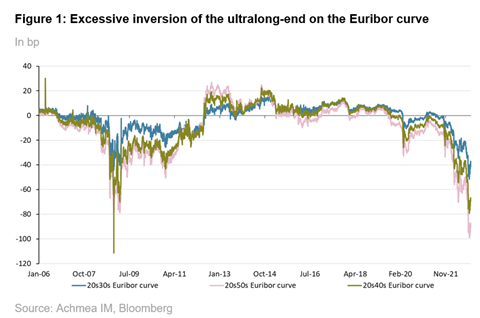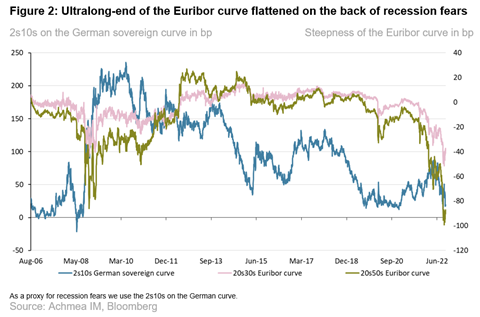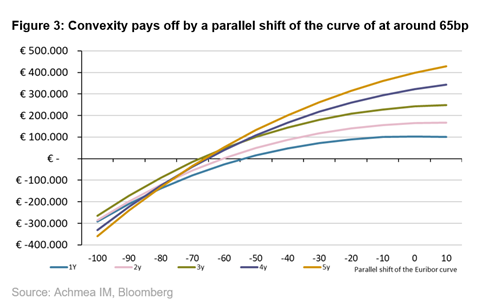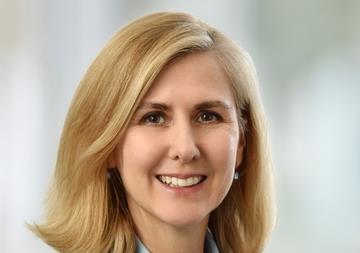Pension funds should consider adjusting their hedging policy as convexity doesn’t seem to payoff anymore
- The inversion of the ultralong-end of the Euribor curve is extreme
- This is most likely driven by Dutch pension funds who increased their hedge ratio in combination with recession fears
- Pension funds should consider the costs of convexity in their hedging strategy
- For example, they can hedge the interest rate sensitivity at the ultralong-end of the curve with shorter-dated maturities, which can have an impact on the flows along the Euribor curve
Convexity doesn’t seem to payoff anymore, given that the 20s50s on the Euribor curve is trading at around -90bp. On the back of this, pension funds could adjust their hedging strategy. For example, the interest rate sensitivity of the liabilities at the ultralong-end of the Euribor curve can be hedged with shorter-dated swaps. This can result in less flows in the ultralong-end of the Euribor swap curve and relatively more flows in the 20y, 25y and 30y area of the curve.
Inversion of the ultralong-end of the Euribor curve is extreme
The ultralong-end of the Euribor curve is extreme inverse, whereby the 20s50s on the curve is trading at around -90bp as shown in Figure 1 below. Since the beginning of this year the curve flattened by more than 70bp. It is often the case that interest rate curves flatten during rate hike cycles, given that longer term yields already reflect the rate hikes well ahead, whereas shorter term rates are still adjusting.

However, the steepness of the ultralong-end of the Euribor curve is driven by demand and supply with only a limited number of big players, like pension funds, insurers and governments.
Moreover, pension funds with a dynamic interest rate hedge strategy will adjust their hedge ratio upwards when a trigger level is reached in a rising interest rate environment. As a result, pension funds will enter into Euribor receiver swaps, which put downward pressure on the ultralong-end of the Euribor curve.
This in combination with recession fears and Dutch pension funds who protect their coverage ratio seem to be the main drivers for the flattening of the ultralong-end of the Euribor curve as shown in Figure 2 below.
In addition, fast money like hedge funds don’t seem to take active positions in the ultralong-end of the Euribor curve, given the uncertainty around the Dutch pension reforms.

The inversion of the ultralong-end of the curve is around the levels which we saw during the global financial crisis in 2008.
Typically, the 2s10s on the German curve is only short-lived and when the market starts to look through the recession fears, the German curve as well as the ultralong-end of the Euribor curve is expected to steepen again.
Convexity doesn’t seem to payoff anymore
As a proxy of the costs of convexity we compare a 20y Euribor swap with a 50y Euribor swap. We keep the interest rate sensitivity the same and hedge about 3000 in delta terms.
Accordingly, the nominal amount for the 20y swap is approximately 19.5 million, whereas this is 10 million for the 50y swap. In our analysis convexity for the 50y swap starts to pay off if the curve shifts by about 65bp, based on a 5y investment horizon as shown in Figure 3 below.

Pension funds should consider the costs of convexity in their hedging policy
Dutch pension funds hedge the bulk of the interest rate sensitivity of the liabilities in the matching portfolio with Euribor swaps and sovereign bonds. Moreover, most of the interest rate sensitivity at the ultralong-end is hedged with Euribor swaps, because of the lack of ultralong-dated sovereign bonds.
Given the extreme negative convexity, it is attractive to hedge the interest rate sensitivity of the 40y and 50y points with shorter-dated Euribor swaps. This means that the interest rate sensitivity will be divided among shorter-dated maturities with the same interest rate sensitivity.
To do so, Dutch pension funds will enter into receiver swaps with a higher notional amount and a higher coupon, which will lead to a higher return on their matching portfolio.
Another reason for Dutch pension funds to hedge their interest rate sensitivity with shorter-dated Euribor swaps is the upcoming Dutch pension reforms. Indeed, in the new system we expect that Dutch pension funds need less ultralong-dated receiver swaps, as the new system embraces ‘life-cycle investing’. It should be noted that this strategy introduces curve risks, as we are still in the current system.
Jolien van den Ende is investment strategist LDI at Achmea Investment Management


















No comments yet